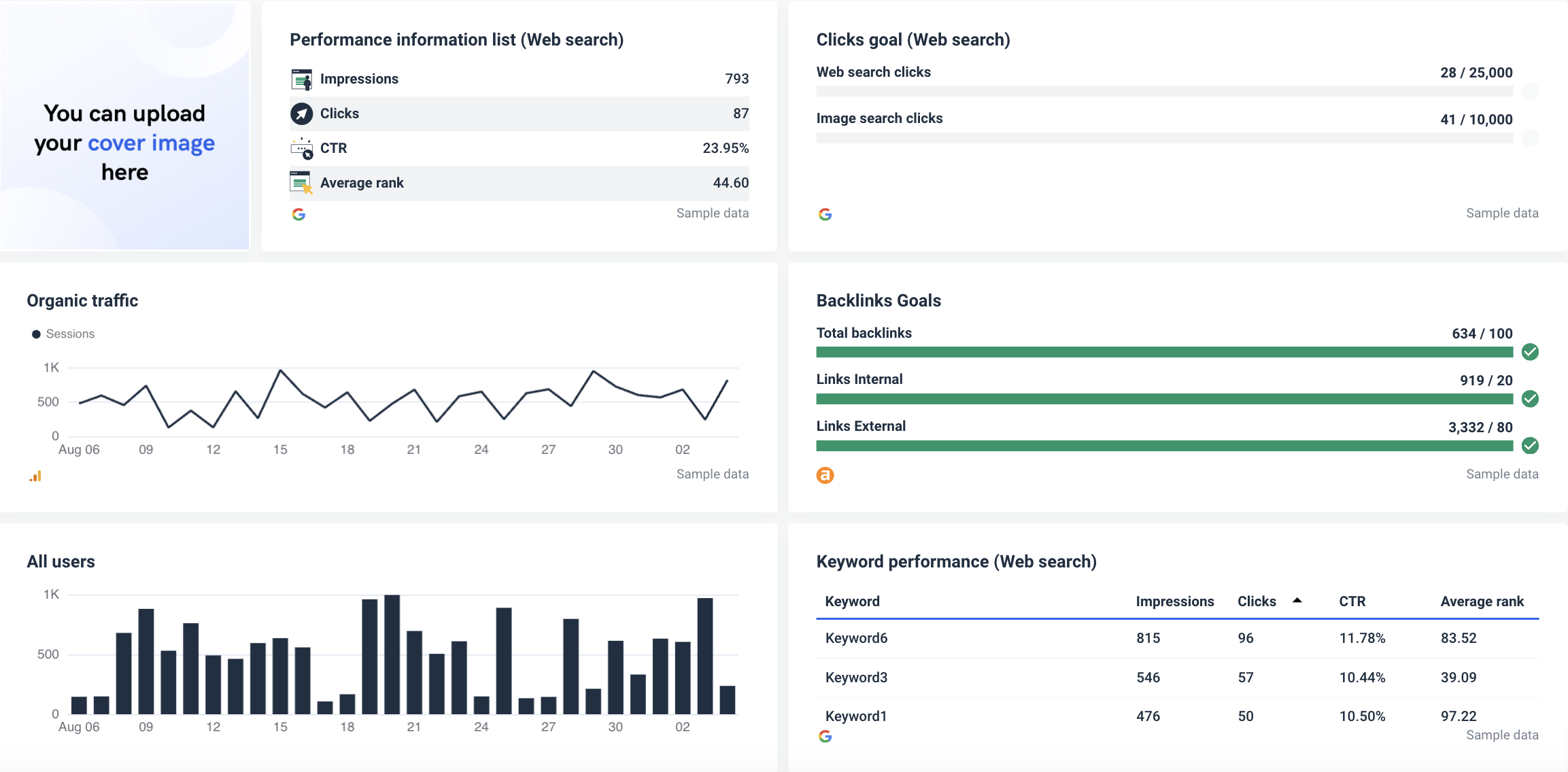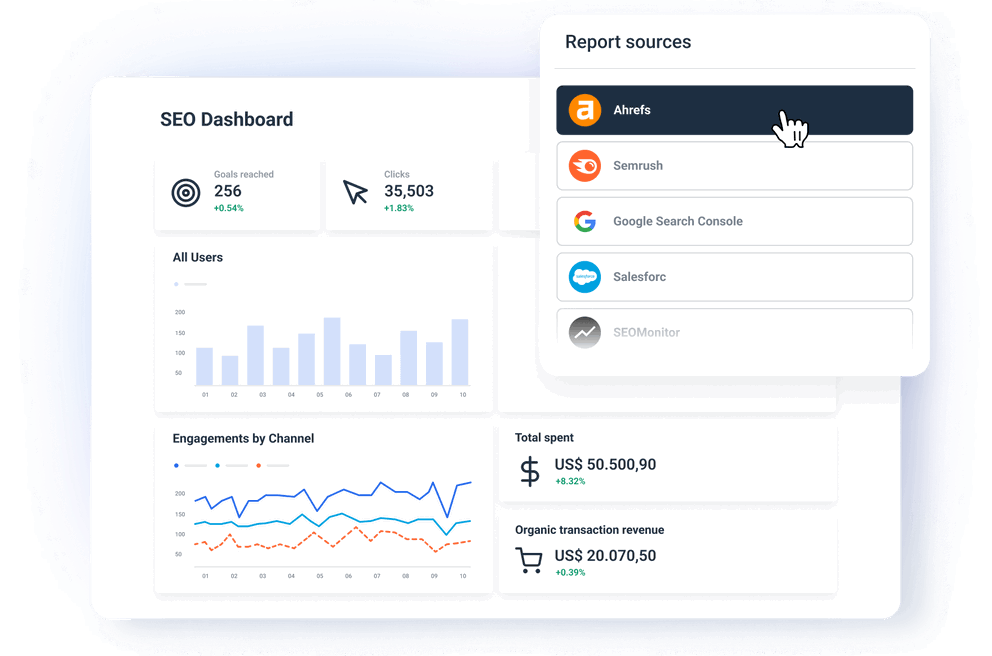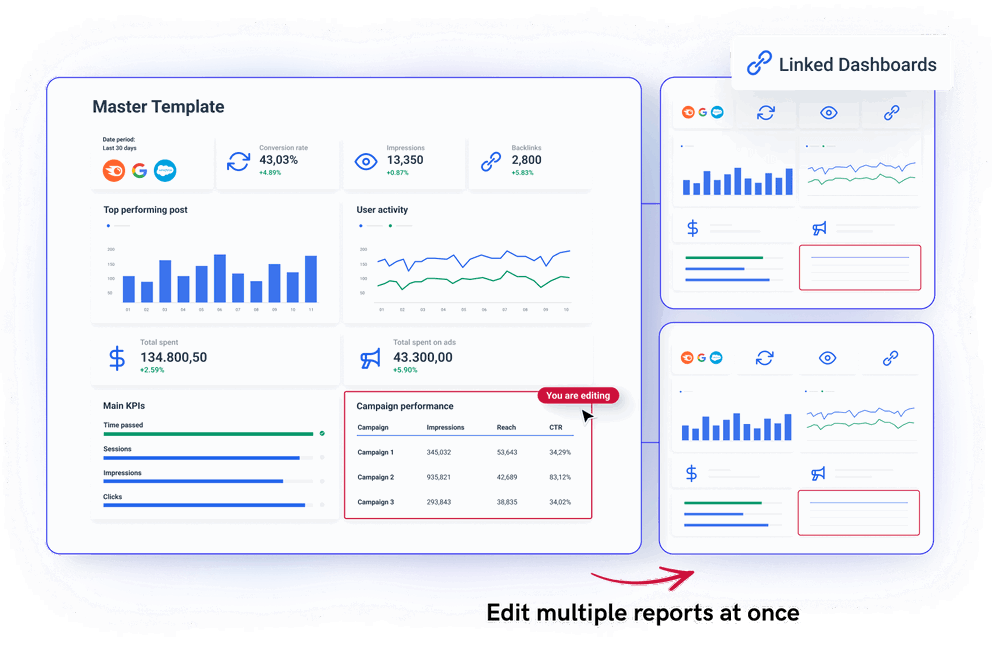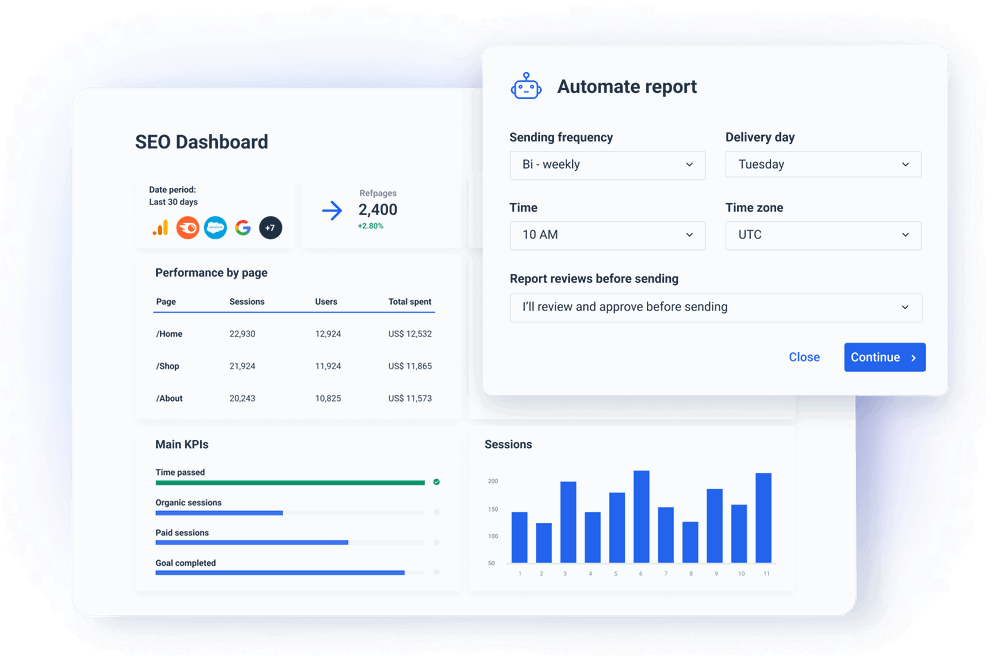What is an SEO dashboard template?
An SEO reporting dashboard template helps you display data from scattered SEO tools — from keyword rankings to new/lost backlinks to page performance and more.
In short, it lets you monitor all the KPIs related to SEO.
No matter which SEO report template you choose, it should help you:
✅ Track keyword rankings and changes over time
✅ Visualize your progress on your SEO KPIs
✅ Identify best-performing keywords and pages
✅ Follow your backlink profile and domain authority
✅ Create white-labeled SEO dashboards and add custom color themes, logos, domains, and more
✅ Measure SEO ROI through dashboard reports that connect to CRM and analytics data
Some of the best SEO reporting tools, like Whatagraph, also offer AI features for automatically creating performance summaries.

How to build an SEO reporting dashboard?
We’ve gone through the basics, but how do you actually build an SEO dashboard?
The best way to build SEO dashboard reports for agencies is to use a dedicated SEO reporting platform, like Whatagraph.
On Whatagraph, you can build an SEO dashboard in five simple steps:
1. Connect your SEO channel integrations
Start by integrating the SEO platforms you want to report on—Ahrefs, Semrush, SE Ranking, Google Search Console, Google My Business, and more.
Choose your data source in Whatagraph’s dashboard, authenticate with your login, and the data will start flowing immediately.
You can also bring in data from 55+ additional marketing channels, like:
- PPC: Google Ads, Snapchat Ads, TikTok Ads, and more.
- Social media: Facebook, Instagram, TikTok, LinkedIn, and more.
- Ecommerce: Shopify, BigCommerce, Magento, and more.
- Email marketing: Klavioy, Mailchimp, ActiveCampaign, and more.
- Analytics: Google Analytics, Matomo, AppsFlyer, and more.
This makes it easy to combine SEO data with data from platforms like HubSpot or Google Analytics 4 and demonstrate SEO ROI through dashboard reports.
2. Organize and clean up your data
SEO data tends to be disorganized and comes from multiple sources—each with its own naming conventions and formats.
Whatagraph helps you group, blend, and aggregate data so it’s easier to understand.
You can:
- Create data blends — Combine sources like SEO and Google Analytics together.
- Group data — Group data from multiple campaigns or countries into regions and tiers.
- Unify naming — Standardize metrics, dimensions, and country names to make dashboards more consistent.
- Build custom calculations and formulas — For example, show clicks across multiple keywords and platforms.
3. Select an SEO dashboard template
This is the important (and fun) part.
You can get started by choosing Whatagraph’s pre-built dashboard for search engine optimisation.
Our templates have important KPIs included. For the SEO report template, these include:
- Organic traffic
- Keyword rankings
- Click-through rate
- Impressions
- Backlink count
- Page-level performance
- And more
Want to white-label your reports? Whatagraph gives you many options. You can:
✅ Add your own custom domain
✅ Embed your logos and custom messaging
✅ Add comment boxes, notes, and headers
✅ Pick different colors for graphs and charts
✅ Change the color schemes in your reports
4. Ask AI to summarize performance
Users don’t want to try to navigate through 30+ sections; they want to know what happened and why it matters. This is what Whatagraph’s AI SEO tool helps with.
You can:
- Ask our AI to write performance summaries based on your data and add them directly to your reports
- Edit the performance summaries further to add a human touch
- Choose short or long summaries
Is your client or executive asking an ad-hoc question? Ask our AI chatbot the question, and it’ll analyze your real-time data and give an answer in seconds.
5. Share your dashboard
Once you’ve added KPIs to your SEO monitoring dashboards, it’s time to send it.
On Whatagraph, you’ve got many ways to share your dashboards:
- Schedule automated emails — White-label your reports and schedule daily, weekly, or monthly reports
- Send live dashboard links — Create a shareable link and let clients view the up-to-date dashboard any time, in-browser
- Export to PDF or CSV — Ideal for presentations or internal sharing
- Push to Looker Studio or BigQuery — For those building more complex BI reporting layers, you can further export your data
What should you include in an SEO reporting dashboard?
Clients don’t want an SEO KPI dashboard filled with 50+ sections. They want a clear, curated report that includes the essentials for their business.
These are the sections we recommend prioritizing:
1. Performance information list
This is a snapshot of the overall performance. Think of metrics, like impressions, clicks, CTR, average rank, and more.
Why it matters:
This is the first thing clients see. It gives them a quick snapshot of the SEO performance, for example, for the last month.
2. Organic traffic trend chart
A line graph showing how organic traffic has changed over time (e.g., the last month).
Why it matters:
This chart gives clients a great visual of how SEO efforts are impacting traffic over days, weeks, or months—without them having to dig through numbers.
3. Backlink goals
A goal graph showing total backlinks, internal links, and external links.
Why it matters:
If you do link building, backlink goals show off-page SEO success. To see how effective your link building campaign has been, you can compare backlinks gained in the past month with the total number.
4. Clicks goal
Shows the number of clicks from web and image search, compared to set goals.
Why it matters:
Besides impressions, clicks are the first tangible SEO metric. Track them to show how effective your title tags, meta descriptions, and overall search visibility are.
5. List of keyword rankings
Table of top keywords and their impressions, clicks, CTR, and the average rank.
Why it matters:
Clients want to know if they are ranking for the right keywords. This section gives a quick overview of the top performing keywords and helps to iterate—if necessary.
6. Organic vs. new sessions comparison
Double-value line chart comparing total organic sessions with new sessions from SEO
Why it matters:
This helps you understand how well SEO is bringing in new users versus returning ones. You can use this chart to show clients how SEO supports brand discovery.
7. Individual KPI widgets
Single-value widgets showing client-specific KPIs, like goal completions, sessions, page views per session, and refpages.
Why it matters:
Different clients prioritize different metrics. These individual widgets allow you to add metrics that your clients value to your SEO client dashboards—quickly.
8. Performance by page
A table showing sessions, users, bounce rates, and average sessions for the top pages.
Why it matters:
Not all pages perform the same. This view helps identify which pages are driving results— and where to focus or pivot.
What key metrics should I display on an SEO dashboard?
In the previous section, we looked at key sections to include. But what metrics should you display inside them?
Here are the key metrics to add to your SEO performance dashboards:
Organic traffic:
The number of sessions that came from search results. A key metric for tracking the overall effectiveness of your SEO work.
Impressions:
The number of times your website appeared in search results. Increased impressions can indicate your search visibility is improving, even if clicks haven’t increased yet.
Web search & image search clicks:
The number of clicks from web searches and Google images. A helpful metric for clients to understand where their traffic is coming from.
Click-through rate (CTR):
The percentage of people who clicked on your page after seeing it in search. A high CTR often means your titles and meta descriptions are optimized—and vice versa.
Average rank:
The average position your keywords hold in search results. A simple (but effective) metric for monitoring if your content is moving up or down the SERPs.
Total backlinks:
The total number of backlinks your website has. If you’re actively building them, you can compare this number to newly acquired backlinks to see how effective your link building is.
Goal completions:
The number of completed actions (like signups or purchases) from organic traffic. A great metric to prove ROI, as it ties your SEO work directly to business outcomes.































